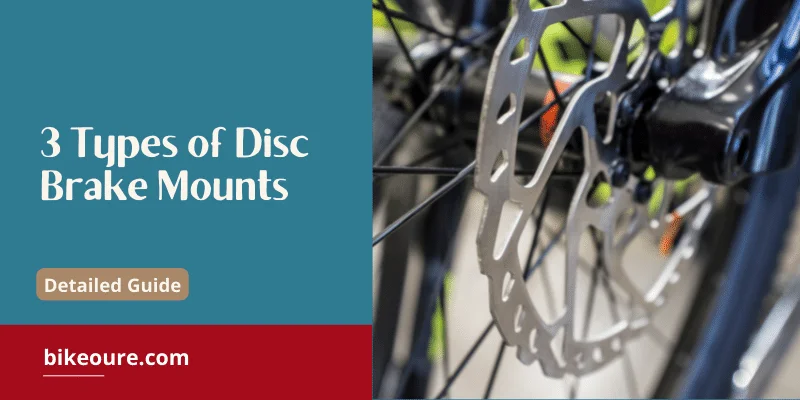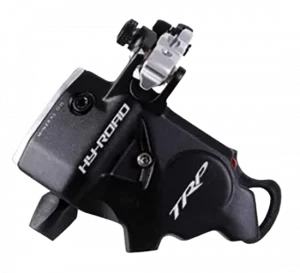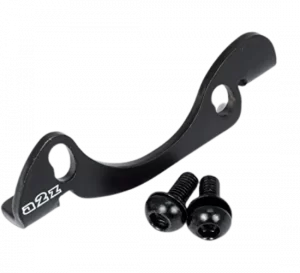While you may think that the disc brake mounts on your bike are similar to all other brake mounts out there. You might be wrong. So, hear me out if you want to know about the types of disc brake mounts because this would help you in the future when you plan to change your bike or just the disc brake mounts.
This article will take you through the types of MTB disc brake mounts and you’ll also know which type is best for which bike. Without further ado, let’s begin with the types.
Contents
3 Types of Disc Brake Mounts

Disc brake mounts have the following three types:
1. Post Mount
2. Flat Mount
3. IS (International Standard) Mount
What are Post Mount Disc Brakes?
In the post-mount disc brake, the bolt holes are parallel to the frame while keeping the bolts 74mm apart. They are directly screwed into the frame. To install brake calipers, you do not need an adapter. The need for an adapter is only when the rotors are larger in size than the size of the post mount. Post mounts are simple, cheap, and highly efficient.

Post-mount disc brakes are more common for mountain bikes due to their increased weight. Most modern frames and forks also use these disc brake mounts. Post-mount brakes were also present on the first gravel bikes. The reason for their wide usage is that they are easy to install and adjust.
What are Flat Mount Brakes?
Shimano introduced flat-mount brakes in first place in 2015 and ever since its launch, it is gaining more popularity than expected. It is different from a post mount in the sense that its caliper sits directly on the chainstay and thus saves space which is not possible with a post-mount caliper.

Almost all road bikes use flat mount disc brakes due to their decreased weight and sleeker appearance but now even cross-country (XC) mountain bikes also use them. Besides, this type is more expensive than other disc brake mounts.
What are IS (International Standard) Mount Brakes?
These were common in the early 2000s and now fork manufacturers have stopped producing them as they prefer post mounts over IS mount brakes. However, it is also true that the rear of some frames still use IS mounts. IS mounts have complex structures and are expensive.

Their bolts are 51mm apart and the placement of these bolts is perpendicular to the bike’s frame. To install a modern hydro disc brake on an IS mount, you’ll be needing an IS to Post mount adapter. However, there are some exceptions in IS mounts that do not take adapters such as Hope, Shimano, and Magura.
You might also wonder how you can mount disc brakes. So, let’s discuss that.
How to Mount Disc Brakes?
- If you have a rim brake and wish to replace it with a mount disc brake, start by removing the brakes already present along with the handlebar levers. You can do it with a screwdriver and Allen keys.
- Start with the front wheel and remove it because it would be difficult for you to install the disc brakes if the front wheel is present. Right after you install the front disc brakes, you can put the front wheel again.
- Before installing the disc brake, make sure you wear gloves so as not to damage it. Also, with the help of isopropyl alcohol on a clean cloth, clean the disc rotor.
- If your wheel has a six-bolt system, snug down all the bolts into the holes on the wheel hub for attaching the disc. Do not apply more force when turning as it may damage the wheel.
- Next, move the rotor clockwise and tighten the bolts manually by making a star-shaped pattern. This pattern would prevent the disc from bending. You can use a torque wrench for this.
- You’ve successfully adjusted the rotor on the wheel hub. Now, take some isopropyl alcohol or a brake cleaner on a clean towel and clean the disc with it.
- Moving further, re-secure the front wheel to the fork. You can select the front brake calipers now and remove caliper spacers (that is a red plastic piece) from them. Keep in mind that it is best to install the spacers right after you remove the rotor from the calipers.
- Slide the caliper over the disc brake for aligning the attachment points properly. During the process, do not tighten the two bolts and keep them loose. This would help you in moving them with your hands when you adjust the brakes.
- Attach the front brakes with the left side of the handlebar plus the brake lever with the handlebars while loosely aligning the brake lines.
- After this, give a light squeeze to the brake lever followed by spinning about 2-4 times. This ensures the proper alignment of the caliper to the disc brake.
- Zip-ties would help in holding the brake lines to the fork and frame according to your needs. With a cutter, you can trim the extra parts.
- Your final step would be adjusting the position of the brake lever and tightening it.
The process for the rear wheel is also the same. After you are done, check for rattles by lifting your bike for 4-6 inches and then dropping it on the ground. You can then take your bike for a ride to confirm the proper working of the brakes.
To help you differentiate among the types of disc brake mounts even better, down below you can find some more questions answered.
FAQs about Disc Brake Mounts
What is the difference between flat mount and post mount?
While the function of flat mount and post mount is the same, both have differences when it comes to the screwing of bolts. Also, a bike with a flat mount is lighter yet expensive, and vice versa.
What is a flat mount disc brake?
A flat mount disc brake is specific for road bikes as it is compact and lightweight. The caliper of a flat mount sits directly on the chainstay and thus saves space which is not possible with a post-mount caliper.
What are the two types of disc brakes?
The two types of disc brakes are as follows:
- Opposed piston disc brake
- Floating disc brake
If both sides of the disc rotor have pistons, it is an opposed-piston disc brake. On the other hand, when the disc rotor has a piston on only one side, you call it a floating disc brake or the sliding pin disc brake.
What are direct mount disc brakes?
Unlike the traditional rim brakes, direct mount disc brakes mount to the bike’s frame or fork between two mounting points instead of one. This makes them stiff and less prone to flex.
Concluding Disc Brake Mount Types
This was all for the different types of disc brake mounts. It is up to you now to go for whichever disc brake mount you prefer. But, know that a flat mount is more popular because it allows you to install post-mount calipers on it with the help of suitable adapters. Likewise. it is not possible the other way around due to the lack of adapters. This can help save you some bucks.

Hi, This is Catharine Pendrel, a professional cyclist and founder of Bikeoure. I have been riding bikes for more than 23 years and writing about cycling and other outdoor magazines for about 5 years. Mountain biking has been my passion ever since I first came across it a decade ago. I participated in various MTB tournaments and won numerous mountain trail races.
I started Bikeoure to share my expertise and cycling experience with cyclists all around the world to make them addicted to cycling. My cycling and solo traveling expertise help new cyclists find the best and latest gear in the market for their cycling adventures.